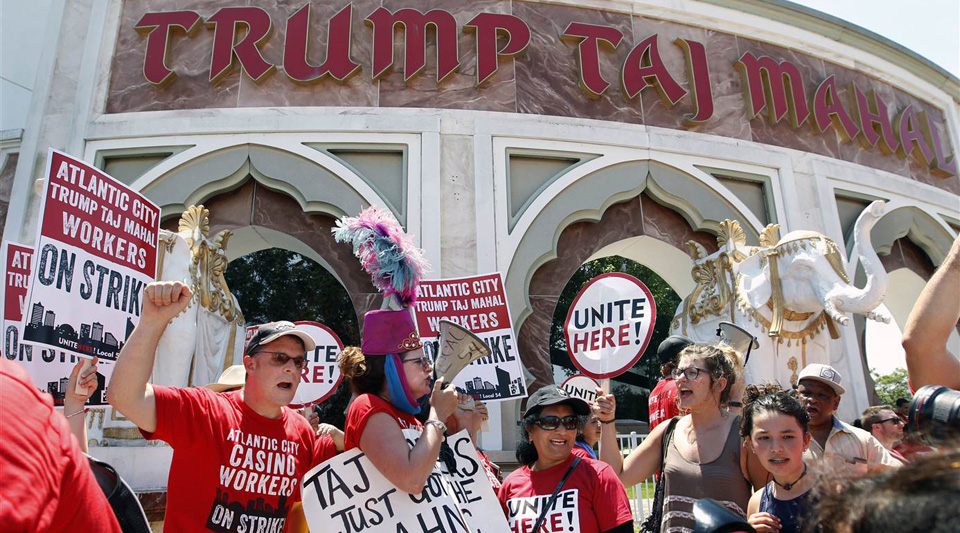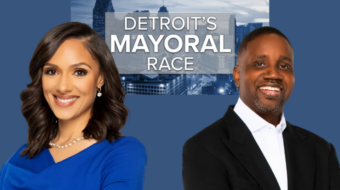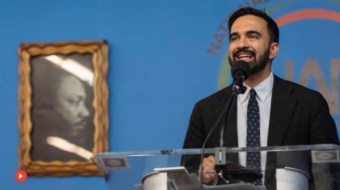
Donald Trump finally admitted during the second presidential debate to paying no federal taxes.
How did the American people get stuck with a tax code which enables a multi-multi-millionaire living in a marble-filled and gold-plated home to pay nothing, while working class families across the nation must pay our fair share?
When I saw the front page of his 1995 tax form printed in the New York Times, I got the idea to go down to the basement to dig up our family’s tax return for that year. Turns out, 1995 was a pretty good year for our family.
Our family income between myself and my husband, Scott, came to $52,396. My contribution came from working 40 hours a week in a sewage treatment plant. Some folks might object to the smell, but it was honest work, and there were great co-workers. Every payday we reminded each other, “S**t smells like money to me.” That year we replaced the washing machine and got a new storm door but other than that our house didn’t need any major repairs. Neither of our aging beaters died on us. We were able to donate a few hundred bucks to some good causes. We took the kids on a two-week camping trip to a national park in Maine and put some savings bonds into a shoebox marked “college fund.”
Scott and I paid $4,446 in federal taxes in 1995. Our Illinois state taxes were $1,314.
We didn’t feel like suckers to pay a tenth of our income in taxes. Our three daughters were getting a good public school education, and our garbage was picked up every Wednesday. The red fire hydrant in front of our house reminded me of the protection of the fire department. OSHA safety rules and inspectors made working in a hazardous place a little safer. It felt right that we would “pay our dues” to the country we live in.
You would think by his taxes, Donald, on the other hand, had a rough year in 1995. He “lost” nearly a billion dollars. But the loss didn’t seem to cramp the Trump family lifestyle.
It’s all about the gold
Was 1995 the year the Trump home, like the Wood-Marshalls’, acquired its new front door? Our $199 Home Depot insulated storm door was quickly encrusted with children’s muddy handprints. The Trumps’ front door is gold-plated and encrusted with diamonds. Really.
Open that diamond-crusted door into the Trump’s three-story penthouse overlooking Central Park and you’ll find what idesignarch Magazine describes as “rivers” of marble and gold, Louis XIV style. Their 58-bedroom Florida mansion Mar-a-Lago follows form with crystal chandeliers. The walls of the Grand Ballroom are inlaid with gold. Bathroom fixtures? Gold. You get the picture. Flush with gold.
The long con
The brilliance of the corporate freeloader lies not just in the accountants. The tax codes and other regulations governing income – such as the bankruptcy laws – are in fact written with built-in loopholes that allow wealthy people to get even richer by not paying taxes.
Con artists such as Trump use the bankruptcy tax rules to make money. It may be easier than making money off of creating real goods and services. Most of us think of bankruptcy as a way for families who fall on hard times to reorganize their debt and get a fresh start. But billionaires like Trump routinely use corporate bankruptcy as a money mill. Two bankruptcies in the early 1990s, the Trump Taj Mahal casino in 1991 and the Plaza Hotel in 1992, most likely set up his big 1995 “loss” of $916 million. This single year of net operating losses resulted in 18 years of him not having to pay taxes on hundreds of millions in profits.
The New York Times reported October 10 that Trump had benefited from a particular use of the business tax code that other wealthy families use. “Known as net operating loss, it allows an array of deductions, business expenses, real estate depreciation, losses from the sale of business assets and even operating losses to flow from the balance sheets of those partnerships, limited liability companies and S corporations onto the personal tax returns of people like Mr. Trump. In turn, those losses can be used to cancel out an equivalent amount of taxable income.”
Another provision of the tax code, called “carry forward,” allows businesses to hang on to their losses to offset future profits for up to 18 years. So his profits from million dollar executive salaries, bonuses, rents, shirt and tie sales, “The Apprentice,” etc. were potentially never taxed due to the carry forward from that 1995 declaration of losses.
Now, more than twenty years later, Trump Taj Mahal, the Atlantic City casino that started the cascade of bankruptcies, is closed. Trump’s billionaire buddy Carl Icahn claims a hundred million-dollar loss of his own after refusing to negotiate with striking casino workers, and 3,000 people in Atlantic City are now unemployed. “Atlantic City was a very good cash cow for me… I took a lot of money out of the casinos with the financings…” he said in a New York Times interview.
So how much money did Donald Trump actually clear from this flim-flam?
New York Times economics writer Eduardo Porter figures that Trump’s ability to avoid taxes on $50 million a year income for 18 years could have saved him almost $400 million in federal taxes and another $150 million in New York state and local taxes.
What did this mean for everyone else in America? Consider that just one year of those taxes would pay to replace all the lead pipes in the city of Flint, Mich. In another example, Porter estimates that the entire half billion would provide child care subsidies for 75,000 children.
Trump’s gold-plated lifestyle, of course, continued. In fact, his bankruptcy deal allowed him to spend $400,000 per month on personal expenses.
Trump’s not the only one
The losses on paper that shielded him from the taxes the rest of us pay were made possible by the control that the billionaire class exercises on the Congressmen who write our tax code. Because Trump is running for president, and has his name emblazoned on his businesses, his schemes are perhaps more visible than others’. But Trump can’t be the only one — others in the top echelon of the 1% also likely help themselves to untaxed profits using similar strategies.
This is what bothers me about the narrative that a business leader should run the country. Our problem is not mismanagement. Our country is quite well managed; but it is managed exclusively for the benefit of the wealthy.
We don’t need a business leader to correct that problem. We need a real democracy.










